
Cyril M. Kornbluth was an American science fiction author and a member of the Futurians. He used a variety of pen-names, including Cecil Corwin, S. D. Gottesman, Edward J. Bellin, Kenneth Falconer, Walter C. Davies, Simon Eisner, Jordan Park, Arthur Cooke, Paul Dennis Lavond, and Scott Mariner. The "M" in Kornbluth's name may have been in tribute to his wife, Mary Byers; Kornbluth's colleague and collaborator Frederik Pohl confirmed Kornbluth's lack of any actual middle name in at least one interview.

Frederik George Pohl Jr. was an American science-fiction writer, editor, and fan, with a career spanning nearly 75 years—from his first published work, the 1937 poem "Elegy to a Dead Satellite: Luna", to the 2011 novel All the Lives He Led.

Algirdas Jonas "Algis" Budrys was a Lithuanian-American science fiction author, editor, and critic. He was also known under the pen names Frank Mason, Alger Rome, John A. Sentry, William Scarff, and Paul Janvier. He is known for the influential 1960 novel Rogue Moon.

James Edwin Gunn was an American science fiction writer, editor, scholar, and anthologist. His work as an editor of anthologies includes the six-volume Road to Science Fiction series. He won the Hugo Award for "Best Related Work" in 1983 and he won or was nominated for several other awards for his non-fiction works in the field of science fiction studies. The Science Fiction and Fantasy Writers of America made him its 24th Grand Master in 2007, and he was inducted by the Science Fiction and Fantasy Hall of Fame in 2015. His novel The Immortals was adapted into a 1970–71 TV series starring Christopher George.

John Stewart Williamson, who wrote as Jack Williamson, was an American science fiction writer, often called the "Dean of Science Fiction". He is also credited with one of the first uses of the term "genetic engineering". Early in his career he sometimes used the pseudonyms Will Stewart and Nils O. Sonderlund.
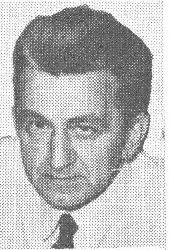
Frank Rudolph Paul was an American illustrator of pulp magazines in the science fiction field.

Ballantine Books is a major book publisher located in the United States, founded in 1952 by Ian Ballantine with his wife, Betty Ballantine. It was acquired by Random House in 1973, which in turn was acquired by Bertelsmann in 1998 and remains part of that company today. Ballantine's logo is a pair of mirrored letter Bs back to back. The firm's early editors were Stanley Kauffmann and Bernard Shir-Cliff.

Ralph Angus McQuarrie was an American conceptual designer and illustrator. His career included work on the original Star Wars trilogy, the original Battlestar Galactica television series, the film E.T. the Extra-Terrestrial, and the film Cocoon, for which he won an Academy Award.
John Carl Schoenherr was an American illustrator. He won the 1988 Caldecott Medal for U.S. children's book illustration, recognizing Owl Moon by Jane Yolen, which recounts the story of the first time a father takes his youngest child on a traditional outing to spot an owl. He was posthumously inducted by the Science Fiction and Fantasy Hall of Fame in 2015.

John Berkey was an American artist known for his space and science fiction themed works. Some of Berkey's best-known work includes much of the original poster art for the Star Wars trilogy, the poster for the 1976 remake of King Kong and also the "Old Elvis Stamp".
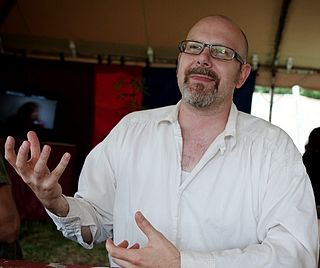
Christopher McKitterick is an American writer of science fiction and an academic concerned with the field. He is Director of the Center for the Study of Science Fiction, a program at the University of Kansas that supports an annual series of awards, lectures, classes, workshops, the Campbell Conference, and AboutSF, a resource for teachers and readers of science fiction.
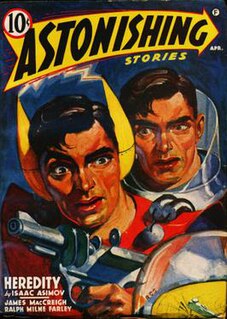
"Heredity" is a science fiction short story by the American writer Isaac Asimov. Asimov wrote the story, his twenty-third, in August 1940 under the title "Twins". It was rejected by John W. Campbell, editor of Astounding Science Fiction, on 29 August, and accepted by Frederik Pohl on 4 September. It appeared in the April 1941 issue of Astonishing Stories under the title "Heredity" and was reprinted in the 1972 collection The Early Asimov. Heredity was the second Asimov story to receive a cover illustration.

"Founding Father" is a science fiction short story by American writer Isaac Asimov. It was first published in the October 1965 issue of Galaxy Science Fiction, and reprinted in the 1975 collection Buy Jupiter and Other Stories. It was inspired by a cover painting of a space-helmeted face backed by several crosses, provided by the magazine's editor, Frederik Pohl.

In 1966, Bantam Books acquired the license to publish tie-in fiction based on the science fiction television series Star Trek.
"The Portable Star" is a science fiction short story by American writer Isaac Asimov, which appeared in the Winter 1955 issue of Thrilling Wonder Stories. "The Portable Star" was Asimov's least favorite story.
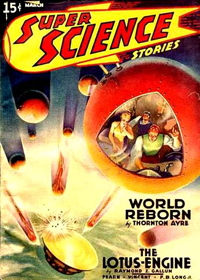
Super Science Stories was an American pulp science fiction magazine published by Popular Publications from 1940 to 1943, and again from 1949 to 1951. Popular launched it under their Fictioneers imprint, which they used for magazines, paying writers less than one cent per word. Frederik Pohl was hired in late 1939, at 19 years old, to edit the magazine; he also edited Astonishing Stories, a companion science fiction publication. Pohl left in mid-1941 and Super Science Stories was given to Alden H. Norton to edit; a few months later Norton rehired Pohl as an assistant. Popular gave Pohl a very low budget, so most manuscripts submitted to Super Science Stories had already been rejected by the higher-paying magazines. This made it difficult to acquire good fiction, but Pohl was able to acquire stories for the early issues from the Futurians, a group of young science fiction fans and aspiring writers.

Star Science Fiction Stories No.1 is the first book in the anthology series Star Science Fiction Stories, edited by Frederik Pohl. It was first published in 1953 by Ballantine Books, without numeration, and was reprinted in 1972 as "No. 1". The book featured the first appearance of Arthur C. Clarke's short story, "The Nine Billion Names of God". These books have been very critically acclaimed by critics around the world.
Astonishing Stories was an American pulp science fiction magazine, published by Popular Publications between 1940 and 1943. It was founded under Popular's "Fictioneers" imprint, which paid lower rates than Popular's other magazines. The magazine's first editor was Frederik Pohl, who also edited a companion publication, Super Science Stories. After nine issues Pohl was replaced by Alden H. Norton, who subsequently rehired Pohl as an assistant. The budget for Astonishing was very low, which made it difficult to acquire good fiction, but through his membership in the Futurians, a group of young science fiction fans and aspiring writers, Pohl was able to find material to fill the early issues. The magazine was successful, and Pohl was able to increase his pay rates slightly within a year. He managed to obtain stories by writers who subsequently became very well known, such as Isaac Asimov and Robert Heinlein. After Pohl entered the army in early 1943, wartime paper shortages led Popular to cease publication of Astonishing. The final issue was dated April of that year.
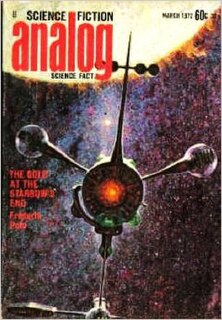
"The Gold at the Starbow's End" is a science fiction novella by American writer Frederik Pohl. Originally published in the March 1972 issue of Analog Science Fiction/Science Fact, it was nominated for both the 1973 Hugo Award for Best Novella and the 1973 Nebula Award for Best Novella. It did win the 1973 Locus Award for Best Novella.

Comets is an anthology of science fiction short stories edited by Isaac Asimov, Martin H. Greenberg and Charles G. Waugh as the fourth volume in their Isaac Asimov's Wonderful Worlds of Science Fiction series. It was first published in paperback by Signet/New American Library in February 1986.

















